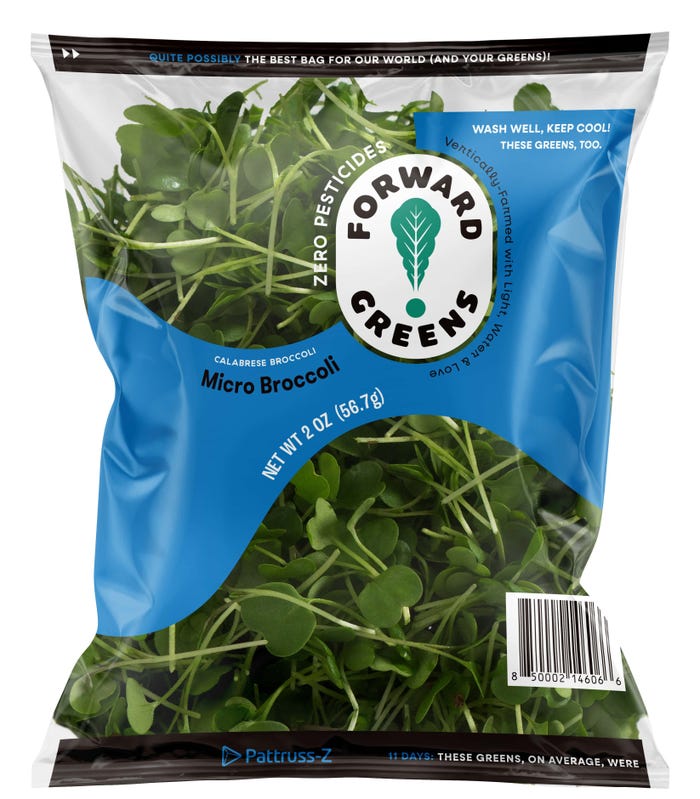Forward Greens' vertically farmed edible plants packaging was changed twice before finding the best metrics-based sustainable option, an OPP pillow pack.

Sometimes the best of intentions doesn’t turn out as expected, which is why the phrase “if at first you don’t succeed, try, try again” was crafted for those whose persistency pays off.
Taking that to heart was Forward Greens, an indoor “vertical farm” brand in Vancouver, WA, that went from PET clamshell packaging to tetrahedral-shaped oriented polypropylene bags to OPP pillow-pack bags. The final iteration was part of a major rebrand this year that centered on using the most sustainable packaging. Ken Kaneko, the company’s founder and CEO, provides answers regarding the packaging and decision-making process.
How did your sustainable journey begin?
Kaneko: Forward Greens’ process for developing a sustainable packaging solution for our greens started with researching waste stream management with local municipalities to understand how we could integrate with the existing infrastructure. Along with the Oregon Department of Environmental Quality and Portland Metro, we ran a Life Cycle Assessment (LCA) to understand the impact of production, logistics, and disposal for available packaging options. From this, we learned that material mass was the largest driver in carbon emissions, and that most plastics, even compostable ones, are not accepted by the municipalities. After synthesizing all the information, we concluded that flexible plastic packaging demonstrated the lowest material mass and thus the lowest carbon emissions.

It would be helpful to know more about your products and customers.
Kaneko: Forward Greens currently has 9 products across baby greens and microgreens, all delivered from farm to market within 48 hours of harvest. We’re unique in that it takes about 19 days from seed to market shelf for our baby greens and about 9 days from seed to market shelf for our microgreens.
Our target customer is anyone who is interested in locally grown, healthy greens — to use for salads, as ingredients, or toppings. We hope we attract those who are especially conscious of their impact on the environment, knowing that with our products, customers are not extraneously stressing the planet. That of course includes our packaging, but also in how we grow the plants themselves. Our sustainable indoor farming practices use 95% less water and 99% less land than outdoor agriculture. We skip the use of herbicides, pesticides and fungicides, and use only non-GMO seeds.
Why was the polymer choice made?
Kaneko: When we rebranded to Forward Greens this summer, we shifted from PET clamshell packaging to OPP flexible packaging to better reflect our mission. The OPP film uses 92% less plastic than traditional clamshells, 12 times less plastic, and produces eight times fewer carbon dioxide emissions compared to, for example, a recycled polypropylene tub.

Comment on the tetrahedral design (seen above).
Kaneko: Forward Greens initially decided to adopt a tetrahedral shape for our packaging to help the product standout, but also for two primary logistical reasons. First, the tetrahedral shape allows for more volumetric space for the greens with the same amount of plastic material. Second, the tetrahedral shape uniquely helps our greens stay safe and avoid getting crushed throughout the distribution process from farm customer’s plates.
Why didn’t that work and what was behind the change to the pillow pack?
Kaneko: There are a few reasons why Forward Greens decided to switch from the tetrahedral shape to the pillow pack. The primary reason is that retailers merchandise based on existing shelving units, which are often paid for by incumbent or slotted brands. Trying something new in that environment is very difficult, both for new brands and the retailers. Even though Forward Greens did receive initial buy-in from our retailers and staff, when it came time for the new packaging to rollout, it was more complicated to accommodate the new shape on the shelf than expected, so we adopted the pillow pack to streamline that process for everyone involved.
|
Also, we used to be known as West Village Farms, but changed our brand to Forward Greens this summer to better reflect our dedication to sustainable practices and our hope to move the entire industry forward. The packaging change from our clamshells to the tetrahedral packaging shape was part of that brand launch. The most-recent package change from the tetrahedral shape to the pillow pack uses the same look that debuted this summer, but in the pillow-pack shape.
As an indoor farm, Forward Greens is constantly trying to improve yields and reduce production costs. Our recent switch from the tetrahedral packaging design to the pillow pack shape increased our content volume and net weight by 33%.
Talk about the timeframe for these changes.
Kaneko: The process for developing both our new packaging and rebrand as Forward Greens from West Village Farms was a huge undertaking. We began the initial planning and development for the new brand in late 2019. The new packaging and brand officially launched the summer of 2020 in the midst of the pandemic.
Switching from the tetrahedral shape to the pillow pack took about four months.
Can you credit the other companies involved?
Kaneko: We worked with Grady Britton, a Portland, OR-based marketing agency, to develop our new brand and packaging design. We wanted the new look to bring to life what we stand for, so the packaging reflects a love of community, food and the planet, while sparking joy. The new look is vibrantly colorful, and part of that is because bagged greens is a crowded market. The new brand design stretches accepted notions of produce packaging design while ensuring the product still looks appetizing. The bag also offers a windowed look inside so customers can see how fresh the greens are.
What feedback have you received?
Kaneko: Forward Greens’ customers and retailers appreciated the effort and unique look of the new packaging shape. We may have just been a little bit ahead of the curve for the greens industry with the tetrahedral packaging shape.
What lessons did you learn the past months?
Kaneko: Brands need to be selective about trying new things at retailer sites. There is a certain speed at which retailers move and it’s very different from the speed at which a company, like Forward Greens, moves. Regardless of the change back to the original pillow pack packaging shape, our fundamental goal is that our packaging has one of the lowest environmental impacts available, all while helping retailers merchandise our greens to the customers who want to buy our products.
About the Author(s)
You May Also Like





